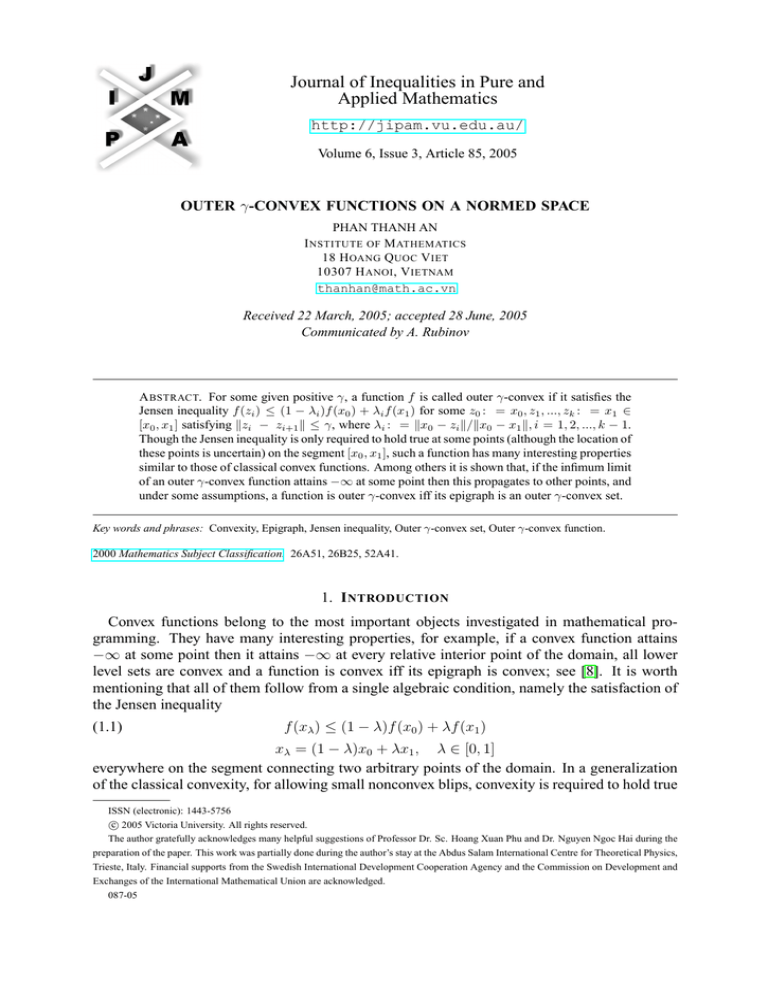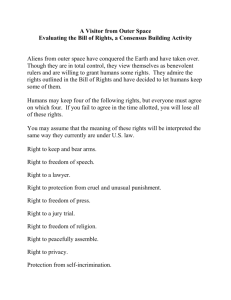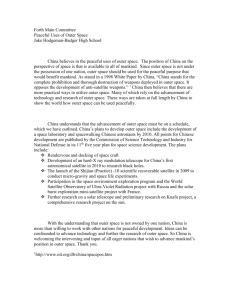
Journal of Inequalities in Pure and
Applied Mathematics
http://jipam.vu.edu.au/
Volume 6, Issue 3, Article 85, 2005
OUTER γ-CONVEX FUNCTIONS ON A NORMED SPACE
PHAN THANH AN
I NSTITUTE OF M ATHEMATICS
18 H OANG Q UOC V IET
10307 H ANOI , V IETNAM
thanhan@math.ac.vn
Received 22 March, 2005; accepted 28 June, 2005
Communicated by A. Rubinov
A BSTRACT. For some given positive γ, a function f is called outer γ-convex if it satisfies the
Jensen inequality f (zi ) ≤ (1 − λi )f (x0 ) + λi f (x1 ) for some z0 : = x0 , z1 , ..., zk : = x1 ∈
[x0 , x1 ] satisfying kzi − zi+1 k ≤ γ, where λi : = kx0 − zi k/kx0 − x1 k, i = 1, 2, ..., k − 1.
Though the Jensen inequality is only required to hold true at some points (although the location of
these points is uncertain) on the segment [x0 , x1 ], such a function has many interesting properties
similar to those of classical convex functions. Among others it is shown that, if the infimum limit
of an outer γ-convex function attains −∞ at some point then this propagates to other points, and
under some assumptions, a function is outer γ-convex iff its epigraph is an outer γ-convex set.
Key words and phrases: Convexity, Epigraph, Jensen inequality, Outer γ-convex set, Outer γ-convex function.
2000 Mathematics Subject Classification. 26A51, 26B25, 52A41.
1. I NTRODUCTION
Convex functions belong to the most important objects investigated in mathematical programming. They have many interesting properties, for example, if a convex function attains
−∞ at some point then it attains −∞ at every relative interior point of the domain, all lower
level sets are convex and a function is convex iff its epigraph is convex; see [8]. It is worth
mentioning that all of them follow from a single algebraic condition, namely the satisfaction of
the Jensen inequality
(1.1)
f (xλ ) ≤ (1 − λ)f (x0 ) + λf (x1 )
xλ = (1 − λ)x0 + λx1 , λ ∈ [0, 1]
everywhere on the segment connecting two arbitrary points of the domain. In a generalization
of the classical convexity, for allowing small nonconvex blips, convexity is required to hold true
ISSN (electronic): 1443-5756
c 2005 Victoria University. All rights reserved.
The author gratefully acknowledges many helpful suggestions of Professor Dr. Sc. Hoang Xuan Phu and Dr. Nguyen Ngoc Hai during the
preparation of the paper. This work was partially done during the author’s stay at the Abdus Salam International Centre for Theoretical Physics,
Trieste, Italy. Financial supports from the Swedish International Development Cooperation Agency and the Commission on Development and
Exchanges of the International Mathematical Union are acknowledged.
087-05
2
P HAN T HANH A N
between points, the distance between which is greater than some given positive real number,
say, the roughness degree. Suppose D is a nonempty convex set in the normed linear space
(X, k · k). According to Klötzler and Hartwig ([1]), a function f : D ⊂ X → R is called
roughly ρ-convex if the Jensen inequality (1.1) is satisfied for all points xλ ∈ [x0 , x1 ] ⊂ D
whenever kx1 − x0 k > ρ, for some given ρ > 0. But the requirement of (1.1) at all points is
sometimes too hard (see [7]). In the concept of Hu, Klee, and Larman [2], a function f is called
δ-convex if (1.1) is fulfilled at each point xλ ∈ [x0 , x1 ] with
δ
δ
and kxλ − x1 k ≥
2
2
for some given δ > 0, which means that at least kx1 − x0 k ≥ δ. According to H. X. Phu, for a
fixed γ > 0, a function f is called γ-convex if
kxλ − x0 k ≥
kx1 − x0 k ≥ γ
implies
f (x00 ) + f (x01 ) ≤ f (x0 ) + f (x1 )
with x0i ∈ [x0 , x1 ], kxi − x0i k = γ, i = 0, 1
([6]). It follows that f must fulfill the Jensen inequality (1.1) at least at x00 or x01 . In addition
to this trend, γ-convexlikeness and outer γ-convexity were introduced respectively in [4] and
[5] (and they are equivalent for lower semicontinuous functions). We recall that a function f is
called outer γ-convex if (1.1) holds true for some points
z0 : = x0 , z1 , . . . , zk : = x1 ∈ [x0 , x1 ]
satisfying
kzi+1 − zi k ≤ γ
(but the location of these points is uncertain). It was shown in [4] that, under some assumptions,
a function is outer γ-convex (convex, respectively) iff the sum of this function and an arbitrary
continuous linear functional always fulfills the property “each lower level set is outer γ-convex"
(“each lower level set is convex", respectively) (see the definition of outer γ-convex sets in
Section 2).
In this paper we show that although the demand “satisfying (1.1) at some points which are
uncertain where" of outer γ-convexity is very weak it could conclude some more similar properties of classical convexity. In Section 2 some similar properties of classical convexity are
given. Among others we get the nearest-point properties (Proposition 2.2). Some properties of
outer γ-convex functions are given in Section 3. In particular, if the infimum limit of an outer
γ-convex function attains −∞ at some point then this propagates to other points (the so-called
infection property) (Proposition 3.4). Finally, under some assumptions, Corollary 4.2 says that
a function is outer γ-convex iff it its epigraph is outer γ-convex.
2. O UTER γ-C ONVEX S ETS
Let (X, k · k) be a normed linear space and γ be a fixed positive real number. For any x0 ,
x1 ∈ X and λ ∈ [0, 1], we denote
xλ := (1 − λ)x0 + λx1 ,
[x0 , x1 ] := {xλ : 0 ≤ λ ≤ 1},
[x0 , x1 [ := [x0 , x1 ] \ {x1 },
]x0 , x1 [ := [x0 , x1 [ \{x0 }.
As usual, B (x, r) : = {y ∈ X : kx − yk ≤ r} denotes the closed ball with centre x and radius
r > 0. Let us recall the notion of outer γ-convex sets ([5]). A set M ⊂ X is said to be outer
γ-convex if for all x0 , x1 ∈ M , there exist z0 : = x0 , z1 , . . . , zk : = x1 ∈ [x0 , x1 ] ∩ M such that
(2.1)
kzi+1 − zi k ≤ γ
J. Inequal. Pure and Appl. Math., 6(3) Art. 85, 2005
for
i = 0, 1, . . . , k − 1.
http://jipam.vu.edu.au/
O UTER γ-C ONVEX F UNCTIONS
3
Obviously, every convex set is outer γ-convex for all γ > 0. Conversely, if a closed set M is
outer γ-convex for all γ > 0 then M must be convex. It follows directly from the following.
Proposition 2.1 ([5]). Let M ⊂ X be outer γ-convex, and let x0 and x1 belong to M . Then
[x00 , x01 [ ⊂ [x0 , x1 ] \ M
implies
kx00 − x01 k < γ.
By virtue of this proposition, such a set M is called outer γ-convex because a segment connecting two points of M may contain at most gaps (i.e., subsegments outside M ) whose length
is smaller than γ.
For each x ∈ X, set M x : = {y ∗ ∈ M : kx − y ∗ k = inf y∈M kx − yk}.
Proposition 2.2. Suppose that M is nonempty and outer γ-convex in X whose unit closed ball
B(0, 1) is strictly convex. Then diam M x ≤ γ for each x ∈ X.
Proof. Assume the contrary that diam M x > γ. Then, there exist x0 , x1 ∈ M x such that
kx0 − x1 k > γ. By the outer γ-convexity of M , there exists z ∈ ]x0 , x1 [ ∩M. The strict
convexity of B(0, 1) implies kx − zk < max{kx − x0 k, kx − x1 k} = kx − x0 k, which conflicts
with x0 ∈ M x.
Note that the assumption of the strict convexity of B(0, 1) is really needed. Moreover, the
converse of Proposition 2.2 is false in case dim X ≥ 2. For example, the compact set
M : = {(x, y) ∈ R2 : x ∈ [−1, 1], y ∈ [−1, 1]} \ {(x, y) ∈ R2 : 0 < y < x}
satisfies diam M (x, y) ≤ γ for all (x, y) ∈ R2 , where γ : = 1. But M is not outer γ-convex.
As can be seen later, the converse of Proposition 2.2 holds true if dim X = 1 and M is closed.
In view of Proposition 2.2, we get the following classical result which is a part of Motzkin’s
Theorem (see [9]).
Corollary 2.3. Suppose that M is nonempty and convex in X whose unit closed ball B(0, 1) is
strictly convex. Then, for each x ∈ X, if the set M x is nonempty, it is a singleton.
Proof. Since M is convex, it is outer γ-convex for all γ > 0. By Proposition 2.2, diam M x ≤ γ
for all γ > 0. It follows that diam M x = 0, i.e., M x is a singleton.
We recall that a set M ⊂ X is γ-convexlike if ]x0 , x1 [ ∩M 6= ∅ holds true for all x0 , x1 in M
satisfying kx0 − x1 k > γ ([5]).
Clearly, each outer γ-convex set is γ-convexlike. In general the converse does not hold. The
situation is quite different if M is closed.
Proposition 2.4 ([5]). Suppose that M is closed. Then M is outer γ-convex iff it is γ-convexlike.
Note that if dim X = 1 and diam M x ≤ γ for each x ∈ X then M is γ-convexlike (Indeed, if
M were not γ-convexlike, i.e., there were x0 , x1 ∈ M , x0 − x1 > γ such that ]x0 , x1 [ ∩M = ∅,
1
1
then M x0 +x
= {x0 , x1 } and therefore diam M x0 +x
> γ, a contradiction). Consequently, by
2
2
Proposition 2.4, the converse of Proposition 2.2 holds true if dim X = 1 and M is closed.
From Proposition 2.4 we have the following.
Proposition 2.5. If M is outer γ-convex then x1 , . . . , xm ∈ M and
inf
x∈conv{x1 ,...,xi−1 ,xi+1 ,...,xm }
kxi − xk > γ
for all i = 1, . . . , m
and m ≥ 2 imply that there exist λi > 0, i = 1, . . . , m, such that
M . If additionally M is closed, the converse is true.
J. Inequal. Pure and Appl. Math., 6(3) Art. 85, 2005
Pm
i=1
λi = 1 and
Pm
i=1
λi x i ∈
http://jipam.vu.edu.au/
4
P HAN T HANH A N
Proof. Suppose that M is outer γ-convex. Then the above condition holds true for m = 2. It
remains to prove that the above condition holds true for m > 2. The proof is by induction on
m. Assume that the assertion holds for m − 1. Let x1 , . . . , xm ∈ M and
inf kxi − xk > γ
x∈Fi
for all i = 1, . . . , m, where Fi : = conv{x1 , . . . , xi−1 , xi+1 , . . . , xm }. It implies that
inf kxi − xk > γ
x∈Fi
for all i = 1, . . . , m − 1. Therefore, by the induction assumption, we conclude that
y: =
m−1
X
λi x i ∈ M
i=1
Pm−1
with some λi > 0, i = 1, . . . , m − 1 and i=1 λi = 1. Since ky − xm k > γ, there exists
λm ∈ ]0, 1[ such that (1 − λm )y + λm xm ∈ M . Hence,
m−1
X
λi (1 − λm )xi + λm xm ∈ M.
i=1
That is, the above condition always holds true.
Conversely, since the above condition holds true for m = 2, M is γ-convexlike. It follows
from Proposition 2.4 that M is outer γ-convex.
3. O UTER γ-C ONVEX F UNCTIONS
Suppose D is a nonempty convex set in the normed linear space (X, k · k). We recall that
f : D ⊂ X → R is outer γ-convex if for all distinct points x0 , x1 ∈ D, there exist z0 : =
x0 , z1 , . . . , zk : = x1 ∈ [x0 , x1 ] satisfying (2.1) and
(3.1)
f (zi ) ≤ (1 − λi )f (x0 ) + λi f (x1 )
where λi : = kx0 − zi k/kx0 − x1 k, i = 1, 2, . . . , k − 1 (see [5]).
Clearly, a convex function is outer γ-convex for all γ > 0. Conversely, if a lower semicontinuous function is outer γ-convex for all γ > 0 then it must be convex. Indeed, if a function is
outer γ-convex for all γ > 0 then it is convexlike (see [1]) and therefore, by lower semicontinuouity, this function is convex.
In [4], a weaker notion of generalized convexity, namely γ-convexlikeness was introduced.
We recall that a function f is γ-convexlike if for all x0 , x1 in D, satisfying kx0 − x1 k > γ, there
exists z ∈ ]x0 , x1 [ such that
(3.2)
f (z) ≤ (1 − λ)f (x0 ) + λf (x1 ),
where λ : = kx0 − zk/kx0 − x1 k.
Then, outer γ-convexity and γ-convexlikeness are equivalent for lower semicontinuous functions.
Proposition 3.1 ([5]). Let f be lower semicontinuous. Then, f is outer γ-convex iff it is γconvexlike.
It is easy to see that a polynomial f (x) = ax4 + bx3 + cx2 + dx + e of order 4 is not convex
on R1 iff 0 < 3b2 − 8ac. But f is outer γ-convex for a suitable γ as the following shows.
Corollary 3.2. Suppose that a polynomial f (x) = ax4 + bx3q+ cx2 + dx + e of order 4 is not
convex on R1 . Then f is outer γ-convex iff a > 0 and γ ≥
J. Inequal. Pure and Appl. Math., 6(3) Art. 85, 2005
1
2a
3(3b2 −8ac)
.
2
http://jipam.vu.edu.au/
O UTER γ-C ONVEX F UNCTIONS
5
Proof. Proposition 3.1 allows us to conclude that outer γ-convexity of a polynomial is equivalent to γ-convexlikeness. Therefore, f is outer γ-convex iff for all x0 , x1 ∈ R1 and x1 − x0 > γ,
there exists λ ∈ ]0, 1[ such that
f (x0 + λ(x1 − x0 )) ≤ (1 − λ)f (x0 ) + λf (x1 ).
This inequality is equivalent to
g(x1 ) = 6ax21 − (4a(2 − λ)p − 3b) x1 + a(3 − 3λ + λ2 )p2 − b(2 − λ)p + c ≥ 0,
where p : = x1 − x0 . Fix p and λ. Then, the polynomial g(x1 ) of order 2 is greater than 0 for
all x1 ∈ R1 iff a > 0 and
(3.3)
8a2 (1 − λ + λ2 )(x1 − x0 )2 ≥ 9b2 − 24ac
holds true for all x0 , x1 ∈ R1 satisfying x1 − x0 > γ.
Now suppose that f is outer γ-convex. It follows from the above that a > 0 and (3.3) holds
for all x0 , x1 ∈ R1 satisfying x1 − x0 > γ. Since λ ∈ [0, 1], 0 < 1 − λ + λ2 ≤ 1. Hence, by
(3.2), 9b2 − 24ac ≤ 8a2 (x1 − x0 )2 for all x0 , x1 ∈ R1 satisfying x1 − x0 > γ. It follows that
0 < 3(3b2 − 8ac) ≤ 8a2 γ 2 .
Conversely, suppose that a > 0 and 0 < 3(3b2 − 8ac) ≤ 8a2 γ 2 . We prove that f is outer
γ-convex. Assume the contrary that f is not outer γ-convex. Then, by (3.3), there exist x0 , x1 ∈
R1 satisfying x1 − x0 > γ and
8a2 (1 − λ + λ2 )(x1 − x0 )2 < 9b2 − 24ac
for all λ ∈ ]0, 1[ . It implies that (x1 − x0 )2 ≤ γ 2 , a contradiction.
It is well known
convex iff the Jenssen inequality holds, namely x1 , .P
. . , xm ∈ D
P that f is P
m
m
λ
f
(x
)
for
all
λ
≥
0,
i
=
1,
.
.
.
,
m
satisfying
λ
x
)
≤
imply that f ( m
i
i
i
i
i
i=1 λi = 1
i=1
i=1
(see, e.g. [8]).
Proposition 3.3. If f is outer γ-convex then x1 , . . . , xm ∈ D and
inf
x∈conv{x1 ,...,xi−1 ,xi+1 ,...,xm }
kxi − xk > γ
for all i = 1, . . . , m
Pm
Pm
and
m
≥
2
imply
that
there
exist
λ
>
0,
i
=
1,
.
.
.
,
m,
λ
=
1,
f
(
i
i
i=1 λi xi ) ≤
i=1
Pm
i=1 λi f (xi ). If additionally f is lower semicontinuous, the converse is true.
Proof. Suppose that f isPouter γ-convex. We apply the P
argument given
P in the proof of Proposition 2.5 again, with “ λi xi ∈ M ” replaced by “f ( λi xi ) ≤
λi f (xi )”, to obtain the
desired result.
Conversely, since the above condition holds true for m = 2, f is γ-convexlike. Hence, by
Proposition 3.1, f is outer γ-convex.
Note that the sufficiency of Proposition 3.3 fails to be true without the assumption on the
lower semi continuity of f .
A property of generalized convex functions is called an infection property if this property
transmits to other places after once appearing somewhere. Phu and Hai ([6]) showed that γconvex functions on R possess some infection properties. Outer γ-convex functions also possess
an infection property as the following proposition shows.
Proposition 3.4. Let f : D ⊂ X → R be outer γ-convex and x0 ∈ D satisfy lim inf x→x0 f (x) =
−∞. If there exists y ∈ D satisfying
(3.4)
J. Inequal. Pure and Appl. Math., 6(3) Art. 85, 2005
ky − x0 k ≥ 2γ
http://jipam.vu.edu.au/
6
P HAN T HANH A N
then there is some
y − x0
y − x0
z ∈ x0 + γ
, x0 + 2γ
ky − x0 k
ky − x0 k
such that lim inf x→z f (x) = −∞.
Proof. Assume that x0 = limm→+∞ xm and limm→+∞ f (xm ) = −∞ with some {xm } ⊂ D.
Since ky − x0 k ≥ 2γ, we also assume that ky − xm k > γ for all m. Set sm : = (y − xm )/ky −
j
xm k. Because f is outer γ-convex, there exist zm
= (1 − λjm )xm + λjm y, j = 1, 2 satisfying
2
1
− zm
k ≤ γ,
kzm
(3.5)
2
1
],
xm + γsm ∈ [zm
, zm
and
j
f (zm
) ≤ (1 − λjm )f (xm ) + λjm f (y),
(3.6)
j
where λjm : = kxm −zm
k/ky−xm k. Since {λjm } ⊂ [0, 1], we can assume that λjm → λj ∈ [0, 1]
j
as m → +∞. It follows that zm
→ z j : = (1 − λj )x0 + λj y as m → +∞, j = 1, 2. We now
consider the following cases:
2
a) If λ2 6= 1, i.e., zm
6→ y as m → +∞. This together with (3.6) yields
2
lim inf f (zm
) ≤ lim inf {(1 − λ2m )f (xm ) + λ2m f (y)}
m→+∞
m→+∞
≤ lim inf (1 − λ2m )f (xm ) + lim sup λ2m f (y)
m→+∞
m→+∞
= −∞.
Therefore
2
lim inf f (zm
) = −∞.
m→+∞
That is,
lim inf
f (x) = −∞.
2
x→z
2
zm
2
∈ [xm + γsm , xm + 2γsm ], we conclude that z 2 ∈ [x0 + γs0 , x0 + 2γs0 ].
Since
2
b) If λ = 1, i.e., zm
→ y as m → +∞. Then, by (3.5), we conclude that kx0 − yk = 2γ,
1
1
zm → z = x0 + γs0 as m → +∞ and therefore λ1 6= 1. Applying the argument given in case
2
1
” replaced by “zm
”, we get
a) again, with “zm
lim inf
f (x) = −∞.
1
x→z
This completes our proof.
Note that the number 2γ in (3.4) is best possible. This is illustrated by
0
if x ∈ {0} ∪ [a, b]
f (x) : =
1
if x ∈ ]0, a[
x(x−a)
(1 < b < 2 and b − 1 < a < 1). Obviously, f is outer γ-convex on D : = [0, b] with γ : = 1.
Choose x0 : = 0 and y : = b then lim inf x→x0 f (x) = −∞ and y − x0 = b < 2γ. In this case,
limx→z f (x) = 0 for all z ∈ [x0 + γ, y] and the conclusion of Proposition 3.4 is false.
In the next section, a Lipschitz condition is assumed and therefore, the infection property
above does not occur.
J. Inequal. Pure and Appl. Math., 6(3) Art. 85, 2005
http://jipam.vu.edu.au/
O UTER γ-C ONVEX F UNCTIONS
7
4. T HE O UTER γ-C ONVEXITY OF F UNCTIONS AND THEIR E PIGRAPHS
Similar to convex functions, outer γ-convex functions can be characterized by their epigraphs.
Theorem 4.1. Suppose that k(x, t)k1 : = max{kxk, |t|} for all x ∈ X, t ∈ R. If epi f is outer
γ-convex then f is outer γ-convex. Conversely, if an outer γ-convex f is Lipschitz continuous
with constant α > 1 (α ∈ [0, 1], respectively) then epi f is outer αγ-convex (outer γ-convex,
respectively).
Proof. Suppose that epi f is outer γ-convex and x0 , x1 ∈ D such that kx1 − x0 k > γ. Then
k (x1 , f (x1 )) − (x0 , f (x0 )) k1 ≥ kx1 − x0 k > γ.
It follows that there exist
A0 : = (x0 , f (x0 )) , A1 , . . . , Ak : = (x1 , f (x1 )) ∈ [(x0 , f (x0 )) , (x1 , f (x1 ))] ∩ epi f
such that
kAi+1 − Ai k1 ≤ γ
Suppose that Ai = (zi , ti ). Then
with
kzi+1 − zi k ≤ kAi+1 − Ai k1 ≤ γ
i = 0, 1, . . . , k − 1.
with
i = 0, 1, . . . , k − 1.
On the other hand, since
Ai = (zi , ti ) ∈ [(x0 , f (x0 )) , (x1 , f (x1 ))] ∩ epi f,
we get
f (zi ) ≤ ti = (1 − λi )f (x0 ) + λi f (x1 )
where λi : = kx0 − zi k/kx0 − x1 k, i = 1, 2, . . . , k − 1. That is, f is outer γ-convex.
Conversely, if an outer γ-convex function f is Lipschitz continuous with constant α > 1
(α ∈ [0, 1], respectively) then epi f is outer αγ-convex (outer γ-convex, respectively). Indeed,
let
Y0 = (x0 , t0 ), Y1 = (x1 , t1 ) ∈ epi f.
Obviously, f is continuous on [x0 , x1 ].
Hence, {(x, t) ∈ epi f : x ∈ [x0 , x1 ]} is closed. Assume without loss of generality, that
Y0 = (x0 , f (x0 )), Y1 = (x1 , f (x1 )).
Suppose
kY1 − Y0 k1 > αγ with α > 1
(kY1 − Y0 k1 > γ with 0 ≤ α ≤ 1, respectively). Then, by k(x, t)k1 : = max{kxk, |t|},
αkx1 − x0 k ≥ |f (x1 ) − f (x0 )|
implies
kY1 − Y0 k1
> γ with α > 1
α
(kx1 − x0 k = kY1 − Y0 k1 > γ with 0 ≤ α ≤ 1, respectively). By the outer γ-convexity of f ,
there exist z0 : = x0 , z1 , . . . , zk : = x1 ∈ [x0 , x1 ] satisfying (2.1) and (3.1). Set
kx1 − x0 k ≥
Ai : = (zi , (1 − λi )f (x0 ) + λi f (x1 )) ,
where λi : = kx0 − zi k/kx0 − x1 k, i = 0, 1, . . . , k. It follows that
A0 , A1 , . . . , Ak ∈ [Y0 , Y1 ] ∩ epi f
and
kAi+1 − Ai k1 ≤ αγ, i = 0, 1, . . . , k − 1 with
J. Inequal. Pure and Appl. Math., 6(3) Art. 85, 2005
α>1
http://jipam.vu.edu.au/
8
P HAN T HANH A N
(kAi+1 − Ai k1 ≤ γ, i = 0, 1, . . . , k − 1 with 0 ≤ α ≤ 1, respectively). Hence, epi f is outer
αγ-convex with α > 1 (epi f is outer γ-convex with 0 ≤ α ≤ 1, respectively), and the proof is
complete.
Corollary 4.2. Suppose that k(x, t)k1 : = max{kxk, |t|} for all x ∈ X, t ∈ R and f is
Lipschitz continuous with constant α ∈ [0, 1]. Then, f is outer γ-convex iff epi f is outer
γ-convex.
Note that the assumptions of norm and Lipschitz condition in Theorem 4.1 and Corollary 4.2
are really needed.
5. C ONCLUDING R EMARKS
Some sufficient conditions for some kinds of outer γ-convex functions, namely strictly γconvex functions and γ-convex functions, were given in [3] and [6]. Some sufficient conditions
for outer γ-convex function will be a subject of another paper.
R EFERENCES
[1] H. HARTWIG, Local boundedness and continuity of generalized convex functions, Optimization,
26 (1992), 1–13.
[2] T.C. HU, V. KLEE AND D. LARMAN, Optimization of globally convex functions, SIAM Journal of
Control Optimization, 27 (1989), 1026–1047.
[3] H.X. PHU, Strictly and roughly convexlike functions, Journal of Optimization Theory and Applications, 117 (2003), 139–156.
[4] H.X. PHU AND P.T. AN, Stability of generalized convex functions with respect to linear disturbance,
Optimization, 46 (1999), 381–389.
[5] H.X. PHU AND P.T. AN, Outer γ-convexity in normed spaces, Vietnam Journal of Mathematics, 27
(1999), 323–334.
[6] H.X. PHU AND N.N. HAI, Some analytical properties of γ-convex functions on the real line, Journal
of Optimization Theory and Applications, 91 (1996), 671–694.
[7] H.X. PHU, N.N. HAI AND P.T. AN, Piecewise constant roughly convex functions, Journal of Optimization Theory and Applications, 117 (2003), 415–438.
[8] A.W. ROBERTS AND D.E. VARERG, Convex Functions, Academic Press, New York and London,
1973.
[9] F.A. VALENTINE, Convex Sets, McGraw-Hill, New York, 1964.
J. Inequal. Pure and Appl. Math., 6(3) Art. 85, 2005
http://jipam.vu.edu.au/








